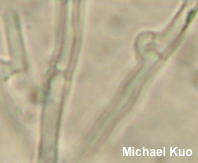| Major Groups > Polypores | Toothed Mushrooms > Trametopsis cervina |

|
[ Basidiomycota > Polyporales > Irpicaceae > Trametopsis . . . ] Trametopsis cervina by Michael Kuo, 13 February 2025 Trametopsis cervina is a fairly distinctive fungus, but it is variable in its appearance. Found on the wood of hardwoods, it often begins as a nearly resupinate patch of white, slotlike pores. Soon, however, some sort of a cap usually develops, either as a folded-over edge or as a well-developed structure—while the pore surface darkens and stretches out, becoming more tooth-like than poroid. At maturity Trametopsis cervina features flattened brownish teeth rather than white pores. Other distinguishing features include the contrasting white cap margin, which is usually present at least until old age; the red to reddish brown reaction to KOH; and microscopic features, including cylindric spores, the absence of cystidia or setae, and a dimitic hyphal system in the flesh of the tubes. Trametes cervina is a synonym, as are Coriolus cervinus, Coriolellus cervinus, Polyporus cervinus, Antrodia cervina, and Antrodia pseudosinuosa, among other combinations. Description: Ecology: Saprobic on the deadwood of hardwoods (usually recently fallen, with bark still adnate), or sometimes appearing on living hardwood trees; annual; causing a white rot of the sapwood; spring through fall, or over winter in warm spells or in warm climates; originally described from North Carolina (von Schweinitz 1822); widespread in North America and Europe; also recorded from The Caribbean, South America, Asia, Africa, and Oceania. The illustrated and described collections are from Georgia and Illinois. Fruiting Body: Often at least partially resupinate, but generally developing folded-over, cap-like edges, or well-developed caps that are laterally fused. Cap: 1–7 cm across (individually); 1–3.5 cm deep; irregular in outline; convex to planoconvex; dry; pale brownish to brown or yellow-brown; sometimes slightly zoned in color and/or texture; rugged; fibrillose to tomentose or nearly bald; the developing margin usually white and contrasting. Pore Surface: White to pale brownish; when young featuring whitish slot-like pores (about 1 per mm), but usually soon becoming more or less toothed, with tube walls elongating and flattening; becoming brownish to brown, or bruising so; tubes 2–6 mm deep. Stem: Absent. Flesh: Thin; tough; whitish at first but soon brownish; not changing when sliced. Odor and Taste: Not distinctive. Chemical Reactions: KOH dark red to blackish on young flesh—or dark brown to reddish brown on older specimens. Microscopic Features: Spores 7–10 x 2–3.5 µm; cylindric to allantoid or long-ellipsoid; smooth; hyaline in KOH; inamyloid. Cystidia not found. Setae not found. Hyphal system dimitic: generative hyphae (found only in tube trama) 2–3 µm wide, smooth, thin-walled, with clamp connections; skeletal hyphae 3–5 µm wide, developing thick walls, rarely septate, without clamps, hyaline to yellowish in KOH. REFERENCES: (L. D. von Schweinitz 1822) M. Tomšovský, 2008. (Overholts, 1953; Gilbertson & Ryvarden, 1987; Kotiranta et al., 2005; Tomšovský et al., 2006; Tomšovský, 2008; Justo & Hibbett, 2011; Ginns, 2017; Gómez-Montoya et al., 2017; Henrici et al., 2018; Læssøe & Petersen, 2019; Liu et al., 2022.) Herb. Kuo 10280703, 07131201, 12151501, 09021903, 10082104, 09292402. This site contains no information about the edibility or toxicity of mushrooms. |
© MushroomExpert.Com |
|
Cite this page as: Kuo, M. (2025, February). Trametopsis cervina. Retrieved from the MushroomExpert.Com Web site: http://www.mushroomexpert.com/trametopsis_cervina.html |











